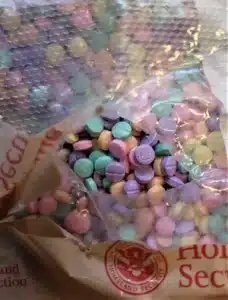What is Rainbow Fentanyl?
Fentanyl is an FDA (Food and Drug Administration)-approved synthetic opioid primarily used for pain relief and numbing. It is an extremely potent drug—50 times stronger than heroin and 100 times stronger than morphine. Even the smallest amounts can cause a fatal overdose. “Rainbow fentanyl” refers to fentanyl disguised in bright, colorful, candy-like forms. In 2022, the Texas Department of State Health Services reported that rainbow fentanyl had been seized in 18 states, including Texas. Initially thought to be a tactic for targeting children, it was later found to be a deliberate method for illegally transporting drugs. However, the biggest danger this drug presents is its undetectability when mixed into other substances, such as common street drugs or counterfeit pills.
 How is Rainbow Fentanyl Reaching Teens?
How is Rainbow Fentanyl Reaching Teens?
Due to fentanyl’s highly addictive properties, it has become a widely produced and illicitly sold drug, accessible across the world. With the rise of mental health issues among adolescents and teens, the demand for a “suppressant” has increased. Since fentanyl is inexpensive to produce, drug traffickers often mix it with other drugs, leading some teens to consume it unknowingly. This is also how rainbow fentanyl is created and distributed. Just one pill can be deadly, and due to its rapid effects, there is little time to react in an emergency. Statistics show that teen deaths from fentanyl overdose increased significantly, rising from 32% in 2018 to 65% in 2020. The drug’s accessibility has made it a growing threat to American youth, putting families at risk.
Common Signs of Overdose and How You Can React
Parents may not always recognize signs of drug use in their children, so it is crucial to know when and how to respond to a potential overdose. If you suspect your teen is overdosing on fentanyl, watch for these signs:
- Altered mental status: Fentanyl can suppress brain activity, leading to the inability to think clearly, causing confusion and lack of response.
- Slurred speech: They are slow to speak or have a slurred speech, making it hard to understand them at times.
- Extreme drowsiness: They are unresponsive or difficult to wake.
- Shallow or no breathing: Fentanyl suppresses breathing, making it potentially fatal.
- Loss of coordination: Slow or uncoordinated movements.
- Pale, bluish, or cold skin: The skin may feel clammy, and other areas of the body can turn cold and blue/gray.
- Constricted pupils: The pupils may shrink drastically, appearing as small black dots.
- Weak pulse: Their pulse or heartbeat may be irregular or extremely slow.
Warning Signs and What Parents Can Do
Having open conversations with your children about drugs can significantly reduce the likelihood of them experimenting with fentanyl or other illicit substances. Setting clear expectations that drug use is unacceptable can also help deter them.
If you notice any signs of overdose, call 911 immediately. After calling, take the following steps:
- Administer Narcan (naloxone) if available: This medication can temporarily reverse the overdose, giving healthcare professionals more time to respond. It can be found at many local pharmacies, some without a prescription.
- Perform CPR: If your child is not breathing or their pulse is weak or absent, perform chest compressions and mouth-to-mouth resuscitation while waiting for medical help.

Don’t wait – Get Expert Care from Surepoint

The rise of fentanyl-laced drugs has made every parent’s worst nightmare a reality. The thought of children being exposed, whether intentionally or unknowingly, is unsettling. Get you loved one to your local Surepoint Emergency Center immediately if you’ve noticed changes in your teen like:
- Changes in speech
- Unusual drowsiness
- Confusion
- Slowed breathing
- Red/Dilated pupils
- Unexplained sweating or jitters
- Or something that just feels off–trust your instincts
Keeping open conversations about the dangers of drugs and having Narcan on hand could save your teen’s life. However, if you suspect your child is having a fentanyl overdose, Surepoint Emergency Centers are open around the clock to provide expert, personalized care and life-saving treatment. We understand the urgency of these moments, which is why we have preventative and assertive measures to address any situation. With state-of-the-art technology in testing traces of any drug, including fentanyl, we can prevent an overdose before it happens. Your child’s safety is our priority.
 When it comes to your family’s health, every second counts. If you’re ever unsure about your loved one’s symptoms, it’s better to err on the side of caution. Surepoint Emergency Centers are here to provide peace of mind and expert care when you need it most.
When it comes to your family’s health, every second counts. If you’re ever unsure about your loved one’s symptoms, it’s better to err on the side of caution. Surepoint Emergency Centers are here to provide peace of mind and expert care when you need it most.
Your family’s health is our top priority. Let Surepoint Emergency Centers be there for you when it matters most.
To find the Surepoint Emergency Center close to you, use our locator tool below:
Surepoint Emergency Center is a modern emergency medical facility open 24/7/365. As an alternative to the traditional hospital ER experience, we offer convenience and minimal wait time, along with highly-trained emergency medical staff and state-of-the-art equipment.
Bringing high-quality emergency care, quickly and easily to your family is our top priority. Committed to making patients feel better faster in a comforting and compassionate environment is what we do.
Fast convenient care in your neighborhood.
References
- CDC. (2021, November 17). Drug overdose deaths in the U.S. top 100,000 annually. https://www.cdc.gov/nchs/pressroom/nchs_press_releases/2021/20211117.htm
- Panchal, N., & Zitter, S. (2024, October 15). Teens, Drugs, and Overdose: Contrasting Pre-Pandemic and Current Trends | KFF. KFF. https://www.kff.org/mental-health/issue-brief/teens-drugs-and-overdose-contrasting-pre-pandemic-and-current-trends/#:~:text=Fentanyl%20deaths%20as%20a%20share,vs%2062%25%20in%202020).
- Texas DSHS. (2022, September 20). Multi-Colored or rainbow fentanyl. https://www.dshs.texas.gov/news-alerts/multi-colored-or-rainbow-fentanyl



